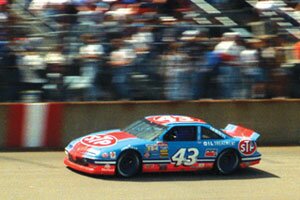THE SPORTS DOCTOR- Bump and grind: New NASCAR rules jeopardize safety

Back when a Pontiac looked like a Pontiac...
Flickr/James Marvin Phelps
As usual, I'll preface this by acknowledging I'm the last to claim any sort of NASCAR expertise, but even if I try, I can't avoid stock car racing altogether. I'm from the South, after all, and Talladega Nights is far more relevant to life in Dixie these days than anything by William Faulkner or Katherine Anne Porter.
So while I can't boast intimate knowledge of NASCAR specifics, its generalities have been well known to me since I was old enough to count to 43. And when fans complain that blazing around a track at 200 miles an hour is passé and tedious, I'm familiar enough with NASCAR to know that no good can come of it.
"There's an age-old saying about NASCAR, ‘If you ain't rubbing, you ain't racing,'" NASCAR president Mike Helton said Thursday.
Such is the explanation given for NASCAR's plan to relax its rules on bumping and horsepower this upcoming season. Let's have more of both! According to the Associated Press, NASCAR is "encouraging drivers to show more aggression and emotion, in large part to answer a growing fan sentiment that the sport had gone stale."
Of all the aw-shucks, boy howdy, dumber-than-dirt reasons to change safety policy.
Of course, more aggression— a great complement to tons of steel, thousands of gallons of high-octane fuel, and maniacal speeds. What's a little common sense in the face of a vocal minority of NASCAR fans?
Yes, ticket sales are down, but no matter what, if fans start crying that races have to be more aggressive to be entertaining, there's a problem.
On the other hand, as Paulie Pabst put it on the Dan Patrick Show last week, "No one wants to see a 42-car parade."
"NASCAR's right to just let the drivers drive," one race fan told me over the weekend. "If you're going to do everything you can to make all the cars identical, then you have to expect the drivers to find other ways to gain an advantage."
As counterintuitive as it may seem to let drivers use more powerful cars to bump each other all over the racetrack, the fact is that NASCAR thinks it has pulled off a pretty neat trick.
Since Dale Earnhardt was killed in a last-lap crash at the 2001 Daytona 500, NASCAR has ramped up car safety. Window nets, HANS restraints, five-point harnesses, roof flaps, roll cages, restrictor plates, fire retardant suits— whew!— all that and a host of other changes have made stock car racing about as safe as it can possibly get. And NASCAR's betting that's safe enough.
After Carl Edwards walked (actually jogged) away from a heart-stopping final-lap crash at the notoriously dangerous Talladega Speedway last year, NASCAR was sure it had done all almost it could in the name of driver safety. Almost.
"Hopefully, they can do something somehow to change this style of racing,'' said Edwards. "I guess we'll do this until somebody gets killed, and then we'll change it."
According to Fanhouse.com, "Instead of changing the tracks, the cars, or the rules, officials indicated it's a case of needing stricter enforcement of those rules, such as issuing more in-race penalties for aggressive driving."
The blocking and bump-drafting that led to Edwards' crash were altogether too dangerous, and NASCAR and the drivers knew it. When questioned about Talladega's aggressive racing style, three-time reigning champ Jimmie Johnson had one thing to say.
"It sucks."
Less than a year later, NASCAR is betting it can keep its safety record intact, even with slackened rules. With the new racing season right around the corner, we won't have to wait long to see if NASCAR's bet is safe enough.
~
Juanita Giles lives in Keysville where she makes videos and updates her Sports Doctor site.
#
1 comment
I $mell Blood!